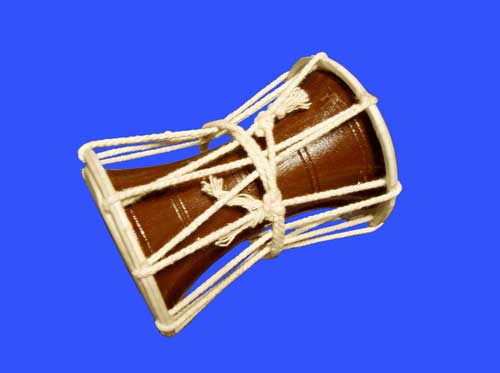
|
Dhad is an instrument very similar to the damaru. Structurally
it is so close to the damaru that perhaps it is not correct to call
it a different instrument. Where the damaru has two knotted chords, dhad does not. Although the structural differences between the dhad
and the damaru are insignificant, the techniques of playing, the
social significance, and the musical capabilities are very
different. two knotted chords, dhad does not. Although the structural differences between the dhad
and the damaru are insignificant, the techniques of playing, the
social significance, and the musical capabilities are very
different.From a technical standpoint, the dhad is played with the hands, while the damaru is played by quickly rotating the drum in such a way that the knotted chords strike the heads. As such, it may be considered to be more of a noisemaker than a serious musical instrument. However the dhad is played with the hands; this gives a much more precise control over the rhythm. This elevates the dhad to the status of a true musical instrument. In both the dhad as well as the damaru, the pitch of the drum is altered. For the damaru it is raised by tightening the rope that wraps around the waist; while for the dhad, it is raised by tightening a small cloth band wrapped around the waist of the drum. Perhaps the greatest difference between the instruments is in the social significance. Where the damaru often has a secular connotation (e.g., beggars with trained monkeys), it is also much associated with the Shivite tradition. The damaru is as iconic among the Shivite sadhus as their trident and their matted hair bun. The dhad on the other hand, is greatly associated with the Sikh bardic tradition. Minstrels known as "dhadis" play the dhad while singing songs and telling stories of the deeds of the Sikh gurus and stories of Sikh history. |
||